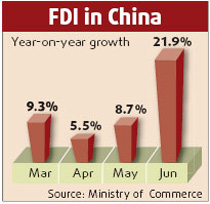Exporters from other countries will have an even bigger presence at the autumn session of the China Import and Export Fair, also known as the Canton Fair, which begins today.
The import section debuted at the country's largest trade fair during the 101st session in spring. The exhibition hall has doubled in size to 20,000 sqm for the autumn event.
The move is part of China's efforts to improve its imports from trade partners and narrow the trade gap, which has sparked widespread concern.
The Canton Fair isn't the only Chinese exhibition turning to imports. The Ninth China Hi-tech Fair, which is being held in Shenzhen between October 12 and 17, has set up a US section in a bid to encourage imports from the United States.
But doubts have been raised as to whether the government can achieve its target of reducing the trade surplus this year, with the figure soaring unexpectedly high in recent months.
Experts predicted the impact of government measures to curb the trade surplus would be seen from July.
Most said the trade surplus would remain high this year but growth would slow.
July's figures proved them right. The surplus for the month, although still high at $24.35 billion, dropped from the record figure in June.
Imports increased over 20 percent year-on-year to $86.38 billion in August.
From January to June, the government took a number of measures to tighten exports - particularly in resource-intensive and low value-added products - and encourage imports.
It lowered the tax rebate on exports of low value-added products, requiring exporters to deposit margins for some processed goods, and imposed export taxes.
Its move to scrap or reduce tax rebates on 37 percent of the country's total exports was the boldest since it joined the World Trade Organization in 2001.
These measures stimulated exports at a time when manufacturers were rushing to deliver goods to meet deadlines.
Chinese companies saw a sharp downturn in export orders in July, according to a survey of purchasing managers by brokerage firm CLSA Asia-Pacific Markets.
That suggests growth in the first half of the year was driven by "a rush of orders to beat the July cut in export tax rebates", said Eric Fishwick, CLSA's deputy chief economist.
Most economists are sticking to predictions that the annual trade surplus for 2007 will be roughly $250 billion to $300 billion, compared with the record $177.47 billion last year.
If there is no significant price increase or adjustment in trade policy, the country's surplus will continue widening to over $250 billion for the whole year, according to researchers at China Construction Bank.
Fan Jianping, a senior analyst at the State Information Center, a key government think-tank, said the figure will touch $275 billion, up 55 percent.
That means surplus growth for the whole year will drop 28 percentage points from the first half.
Slowdowns are also expected in individual sectors, including steel and textiles, which used to produce China's trade surplus.
The 2-percentage-point reduction in tax rebates on garment exports and measures to slow process trade is expected to hit domestic textile manufacturers, said an official with the China National Textile and Apparel Industry Council, who declined to be named.
Growth of steel exports from China will slow to 20 percent for the full year due to government efforts, compared with the 97.7 percent increase in the first half, the China Iron and Steel Association said.
The forecast growth rate would be the slowest since 2003, according to the association.
But Wang Qian, an economist at JPMorgan Chase in Hong Kong, said the surplus in the second half will "stay solid", as strong global demand will counter other factors that may dampen trade growth.
(China Daily October 15, 2007)


